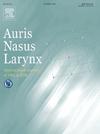Clinical impact of 68Ga-DOTATOC PET on treatment decisions in jugulotympanic paragangliomas: A case series
IF 1.5
4区 医学
Q2 OTORHINOLARYNGOLOGY
引用次数: 0
Abstract
The study aimed to highlight the complementary roles of computed tomography (CT), magnetic resonance imaging (MRI), and gallium-68 DOTA-(Tyr³)-octreotide positron emission tomography (68Ga-DOTATOC PET) in the diagnosis and treatment of jugulotympanic paragangliomas. We present cases of three patients: a 48-year-old woman with tympanic paraganglioma associated with left facial paralysis (patient 1), a 60-year-old man with asymptomatic jugular paraganglioma (patient 2), and a 73-year-old woman with a small tympanic paraganglioma (patient 3). All patients underwent CT, MRI, and 68Ga-DOTATOC PET imaging. Tumor localization, extent, and anatomical relationships were assessed using CT and MRI. Functional confirmation of neuroendocrine tumor identity and exclusion of multifocal or metastatic disease were achieved through 68Ga-DOTATOC PET. CT and MRI provided high-resolution anatomical details. 68Ga-DOTATOC PET demonstrated intense radiotracer uptake in all lesions, including a 4-mm lesion in patient 3, with no evidence of multifocality or metastasis. Patient 1 underwent complete tumor resection with facial nerve reconstruction. Patient 2 was treated with radiotherapy. Patient 3 underwent transcanal resection with ossicular preservation. In conclusion, 68Ga-DOTATOC PET serves as a valuable adjunct to CT and MRI for evaluating jugulotympanic paragangliomas, confirming diagnosis, and supporting precise treatment planning.
68Ga-DOTATOC PET对颈鼓室副神经节瘤治疗决策的临床影响:一个病例系列
本研究旨在强调计算机断层扫描(CT)、磁共振成像(MRI)和镓-68 DOTA-(Tyr³)-奥曲肽正电子发射断层扫描(68Ga-DOTATOC PET)在颈鼓室副神经节瘤诊断和治疗中的互补作用。我们报告了三例患者:一名48岁的女性伴有左侧面瘫的鼓室副神经节瘤(患者1),一名60岁的男性伴有无症状的颈静脉副神经节瘤(患者2),一名73岁的女性伴有小鼓室副神经节瘤(患者3)。所有患者均行CT、MRI和68Ga-DOTATOC PET成像。利用CT和MRI评估肿瘤的定位、范围和解剖关系。通过68Ga-DOTATOC PET确认神经内分泌肿瘤的功能,并排除多灶性或转移性疾病。CT和MRI提供了高分辨率的解剖细节。68Ga-DOTATOC PET显示所有病变都有强烈的放射性示踪剂摄取,包括患者3的4毫米病变,无多灶性或转移的证据。患者1行全肿瘤切除及面神经重建。患者2采用放射治疗。患者3行经骨切除,保留听骨。总之,68Ga-DOTATOC PET可作为CT和MRI的重要辅助手段,用于评估颈鼓室副神经节瘤,确认诊断,支持精确的治疗计划。
本文章由计算机程序翻译,如有差异,请以英文原文为准。
求助全文
约1分钟内获得全文
求助全文
来源期刊

Auris Nasus Larynx
医学-耳鼻喉科学
CiteScore
3.40
自引率
5.90%
发文量
169
审稿时长
30 days
期刊介绍:
The international journal Auris Nasus Larynx provides the opportunity for rapid, carefully reviewed publications concerning the fundamental and clinical aspects of otorhinolaryngology and related fields. This includes otology, neurotology, bronchoesophagology, laryngology, rhinology, allergology, head and neck medicine and oncologic surgery, maxillofacial and plastic surgery, audiology, speech science.
Original papers, short communications and original case reports can be submitted. Reviews on recent developments are invited regularly and Letters to the Editor commenting on papers or any aspect of Auris Nasus Larynx are welcomed.
Founded in 1973 and previously published by the Society for Promotion of International Otorhinolaryngology, the journal is now the official English-language journal of the Oto-Rhino-Laryngological Society of Japan, Inc. The aim of its new international Editorial Board is to make Auris Nasus Larynx an international forum for high quality research and clinical sciences.
 求助内容:
求助内容: 应助结果提醒方式:
应助结果提醒方式:


